In the midst of extreme winter weather with almost zero birds in the field, after returning from a sunny drive as far as 16 miles south of my office, I had my camera within reach when the Harris’s Sparrow perched above my platform feeder. It paused long enough on the apex of a shepard’s hook I use to hang my suet cage from, giving me time to grab my camera and raise it into position. The sun was positioned low in the afternoon sky, and with a juniper tree with new snow covering the top of some branches mostly out of focus in the background, it looked like a pleasing photo setup, so I followed through.
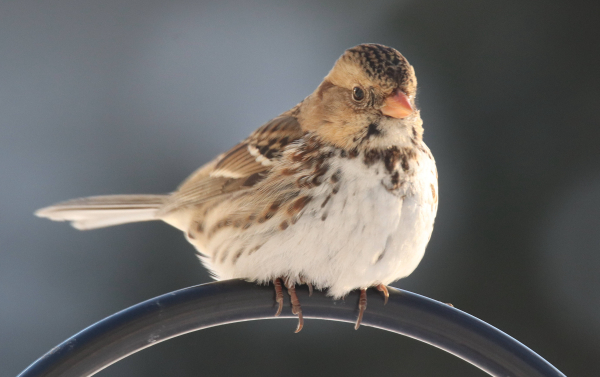
I took a quick photo to start, anticipating the singular sparrow would reposition in a second, but I kept snapping photos as it turned its head, turned its entire body to one side, then another, and as it leaned forward to view the clay platform feeder that contained tantalizing shelled black oil sunflower seeds. Early on, I did take an extra moment to check what a couple photos looked like in the LCD viewer on the back of the camera, and seeing great promise in the resulting images, I quickly focused on the still perched Harris’s Sparrow. At that point it made a pleasing move to hang low with its tail pointed almost straight up while peering down at the feeder, and the resulting photos were among my favorites.
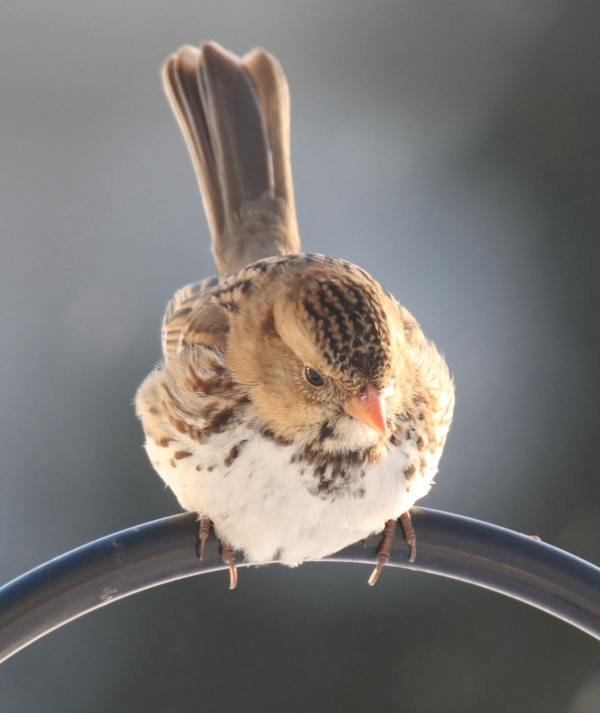
During a single photo opportunity that only lasted about 30 seconds, this series of photos shows the wintering Harris’s Sparrow from a variety of positions – this one is a favorite (600mm zoom lens, f-7 aperture, 1/160 shutter speed, 800 ISO).
|
The Harris’s Sparrow is the first that’s ever spent the winter in my yard, and the species is very rare anywhere this far north after early November. It is an immature bird that I’ve been trying to photograph the past couple weeks in particular, but it is usually nimble, pausing only a brief moment before repositioning to another perch or to the platform feeder where it tends to be surrounded by a few House Finches with an occasional White-breasted Nuthatch zipping in to grab a shelled peanut half. Since Saturday, it’s been more of the same, but I’ve been continuing to be prepared for chances to photograph the rare winter sparrow, and taking advantage occasional opportunities to photograph House Finches, nuthatches, and Oregon Dark-eyed Juncos.
It sounds easy, but believe me, these small songbirds operate at a fast pace that dictates that they rarely pause long enough for a swift autofocus to zero-in before they are on the move again. When I did get a photo op, I needed to act fast and try to anticipate the birds’ next move or moves. But that’s part of the fun of photographing songbirds, while taking a number of photos when opportunities arise.
On the technical side, I emphasized a fairly narrow aperture, ranging from f-7 to f-6; mostly to throw the background out of focus, which helped to emphasize the bird against the background. By using the narrower aperture, it also kept the corresponding shutter speed a little faster, although with the moody dark background the shutter speeds were far less than optimum.
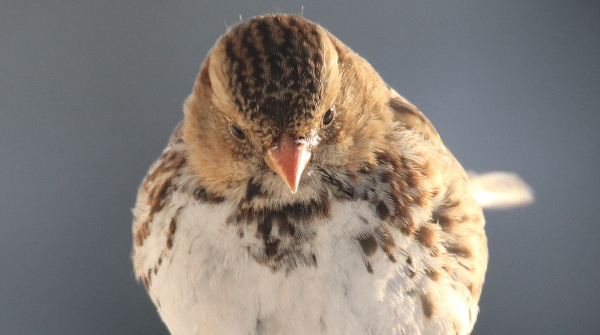
When the Harris’s Sparrow dropped down to the platform to feed, the snowy background brightened the scene and there was more light available overall, which increased the shutter speed dramatically, from 1/60 to 1/1600. The brighter setting created a very different image compared to the initial series of photographs with the dark background. Just the same, I like the way the dark background helped to emphasize the sparrow; it almost gives the impression of a studio photo.
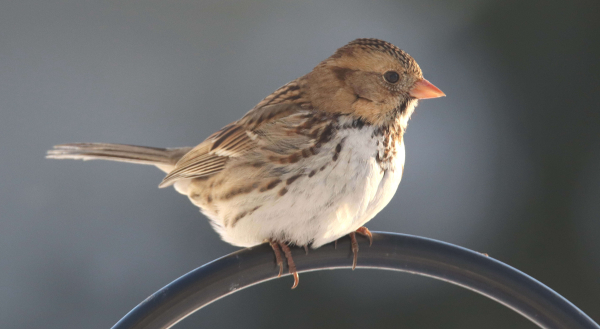
For better or worse, all the photographs that illustrate this article were taken through a single pane of glass from indoors. Normally, photographers frown on this practice because it compromises the quality of the photos taken with a high-quality lens, but for the purpose of photographing from indoors during ultra-cold weather it does illustrate that quality photos of small birds at a feeding station are possible without compromising the image quality too much.
There were 2 more reasons to photograph from indoors – it has been mighty cold outdoors, with the warmest midday temperatures hovering around zero or below (not counting the much colder wind chill factor), and partly because the Harris’s Sparrow is very wary and probably wouldn’t approach the feeder area if I was positioned outside.
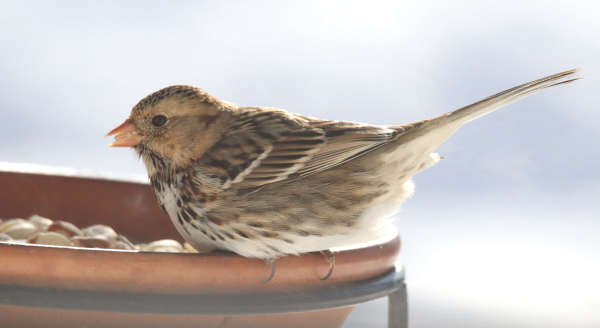
Overall, it’s been a good practice to zero in on the songbirds at my feeders during recent days; I learned when the best period to photograph at my feeders and the adjacent trees is during sunny days – late afternoon between 3 and 4:15. The afternoon photography also helped to satiate my need to get some birding action in, while sharpening my photography edge, including anticipating birds’ actions with a faster reflex on the shutter button. It also provided a few more nice images of the Harris’s Sparrow – my favorite species of native sparrow – and it’s the first to winter here.
As I write this I reflected about how nice it would be if the Harris’s Sparrow stayed long enough to show me the spring molt sequence into its breeding plumage. That’s a possibility considering Harris’s Sparrows have extensive black on their face, neck, and breast when they arrive from the south for a stopover period in May. In the meantime, I hope you have a fine GBBC weekend, punctuated by Valentine’s Day and Presidents’ Day; and be sure to have your camera ready during any birding periods you plan – at home or at a favorite birding location – or both. Good Luck!
Article and Photographs by Paul Konrad
Share your bird photos and birding experiences at editorstbw2@gmail.com